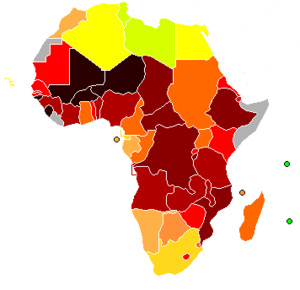During the 1950’s, Africa was a continent awakening to the prospects of Independence. In the 1960’s, Africa was a continent in transition for during the decade 31 African countries South of the Sahara became independence, 17 of them in 1960 alone. Notable progress was school enrollment and some industrialization.
In the 1970’s, Africa was a continent in Limbo. Development proved difficult, and regional and ethnic conflicts became rampant. The cold war placed African countries between the USA and Russia. Increases in oil prices by OPEC in 1973 affected the economic development of the African countries. The 1970’s were also periods of Sahelian drought and famine.
During the 1980’s, it became clear that Africa was a continent in decline. Hunger and starvation in Ethiopia, Sudan and Somalia. Civil wars in Angola, Sudan, Mozambique and Southern Africa. In the 1990’s, Africa was a continent in Crisis. Economic stagnation continued to deteriorate. Rapid spread of AIDS threatens families and general societies.
Today; in the 21st century – Africa is described as the continent of hope with lots of opportunities for investment in the agriculture and energy sector… Below are 30 interesting things (most economical) you didn’t know about Africa.
- The largest population in Sub-Saharan Africa is 151.3 million in Nigeria; the smallest is 0.1 million in Seychelles.
- South Africa’s and Nigeria’s GDP in nominal prices comprised over fifty percent (51.4 percent) of total SSA’s GDP.
- SSA GDP growth was 5.1 percent. Angola had the largest growth at 14.8 percent while the lowest was Botswana with a negative growth (-1.0 percent).
- South Africa has SSA’s largest real GDP ($183 billion); the smallest is Guinea Bissau ($202 million).
- Equatorial Guinea has SSA’s highest GNI per capita ($14,980); Burundi has the lowest ($140).
- The total GDP per capita of the richest 10 African countries was 25.2 times of the poorest 10.
- Between 1990 and 1999 PPP GDP per capita growth was 15 percent ($1,158.9 to $1,327.8) for Sub-Saharan Africa; in between 2000 and 2008 it was 54 percent ($1,372.9 to $2,113.9).
Exports rose from $319.0 billion in 2007 to $413.7 billion in 2008, a 29.7 percent rise; conversely, imports rose less than exports, from $305.3 billion in 2007 to $372.1 billion in 2008, a 21.8 percent rise.
- Total trade as percentage of GDP is the highest in Seychelles, 283.4 percent and lowest in Central Africa Republic, 37.5 percent.
- In two thirds of SSA countries, one or two products are responsible for at least 75 percent of the country’s total exports.
- On average, the merchandise export within trade blocs is 8.4 percent of total bloc exports.
- Cape Verde receives the highest net ODA per capita ($438.2); Nigeria receives the lowest ($9.5).
- The highest private sector fixed capital formation as share of GDP is Cape Verde at 33.7 percent; the lowest is Angola at 1.8 percent.
- In Guinea-Bissau, the agriculture value-added as percentage of GDP is 51.5 percent; in Botswana it is 1.6 percent.
- South Africa uses the most electric power per person (4,809.0kW/h); Ethiopia uses the least (38.4 kW/h).
- In 2007, Burundi has the highest proportion of women in its labor force (90.2 percent); Sudan has the lowest (32.8 percent).
- Equatorial Guinea has the highest proportion of men in its labor force (93.8 percent); Namibia has the lowest (60.3 percent).
- In 2007, almost one in every three 15-49 year old in Swaziland has contracted HIV (26.1 percent); the rate is one in every thousand in Mauritania.
- For the period 2007-08, Seychelles has the highest life expectancy (73 years); Mozambique has the lowest (42 years).
In the decade (1997-2007) Rwanda and Sierra Leone have made the greatest gains in life expectancy: 11 and 8 years respectively. Conversely, life expectancy has decreased 13 years in Lesotho, and 10 years in South Africa and Swaziland.
- For the period 2007, Zimbabwe has the highest adult literacy rate (91.2 percent); Mali and Burkina Faso have the lowest (28.7 percent).
- In Seychelles, 92 percent of women are literate; the figure is 13 percent for Chad and 15 percent for Niger.
- Cape Verde has the highest gross enrollment rate in secondary education (90 percent); Niger has the lowest (11 percent).
- In Mauritius there are 22 children per primary school teacher; there are 91 in Central African Republic.
- In Burundi, 63.1 percent of children under the age of 5 are short for their age; in Senegal it is 20.1 percent.
- The highest connection charge for a business phone is $366.6 in Benin; the lowest is in Ghana at $0.7.
- South Africa has 924 mobile phones per 1000 people; Eritrea has 22 per 1000 people.
- South Africa has the longest rail lines of 24,487 km and Uganda has the shortest of 259 km.
- In 2010, starting a business in Guinea requires 213 days for each procedure; it takes 3 days in Rwanda.
- In 2010, Sudan has the highest number of procedures to enforce contracts of 53; Rwanda has the lowest of 24.
Source: The World Bank
Related articles
- Europe needs Africa. Who’d have thought it? | Knox Chitiyo (guardian.co.uk)
- Google bets on Africa as the next Internet hotspot (thenextweb.com)
- Africa’s Financial Sector: Consumers, Investors and Growth (africamutualfund.wordpress.com)
- Africa could come close to doubling GDP by 2020 versus 2007 (nextbigfuture.com)










